Perks of Lingual Braces

As modern technology has improved the tools and appliances that are now used in orthodontic offices, there are more options than ever for patients to get straighter teeth without the look of traditional metal braces. Lingual braces are an ideal option for patients who want orthodontic care but in the most discreet way possible. By using a hidden apparatus on the tongue-side of your teeth, you can get straight, beautiful teeth without sacrificing your confidence. Find out what other perks lingual braces have and what treatment looks like with this guide!
What Are Lingual Braces?
Braces have come a long way since they were first invented, and patients have more options than ever to get the straight teeth they want without sacrificing their confidence. Traditionally, metal braces were the most common type of orthodontic appliance used but were bulky and aesthetically not very pleasing. With the modern technology that has been developed during the last few decades, one type of braces in particular has become more and more common. Lingual braces are an alternative to traditional metal braces and provide utmost discretion as they are almost completely hidden. Unlike traditional braces whose brackets are attached to the front of the teeth, lingual braces are attached to the back side (tongue-side) of teeth, making them practically hidden from view. Fortunately, lingual braces can provide the same results as traditional braces but in a manner that is nearly undetectable. These braces are particularly helpful for patients, especially teenagers, who think braces are unattractive or distracting. Now, more than ever, patients can receive the orthodontic treatment they need without putting it off for aesthetic reasons.
How Lingual Braces Differ From Other Options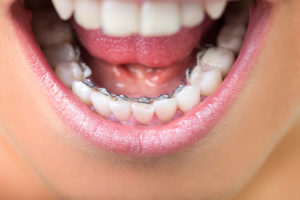
While the obvious advantage of choosing lingual braces over other orthodontic appliances deals with the invisibility of the braces themselves, there are other reasons why lingual braces might be the best option for you. Since their invention in the 1980s, lingual braces have slowly gained recognition as a viable option for orthodontic treatment. In fact, very few dentists even offer this technique because special training is needed to perform it. You will still need X-rays, molds and impressions of your teeth to begin treatment, just like you would when getting any other orthodontic treatment. The process is relatively easy to install them, as the brackets are glued to the lingual side of the teeth with a wire and elastics (if needed) to help move the teeth into position. Lingual braces are always on during treatment, so they are constantly shifting your teeth into the correct position without you or others noticing. A similar treatment to lingual braces is called Invisalign, which uses a removable aligner to straighten teeth. Invisalign is a popular option because the aligner is clear and removable so most people don’t notice it’s there, but not everyone is eligible for Invisalign. While Invisalign is a great option, lingual braces tend to be more helpful for patients with specific concerns. Athletes benefit greatly from lingual braces as it helps prevent mouth injuries since the brackets aren’t on the front of the teeth. Musicians, like those who play a wind instrument (flute, trumpet, clarinet, etc.), are also common wearers of lingual braces as they tend to not get in the way as much when playing. Lastly, those patients who don’t qualify for Invisalign typically choose lingual braces as it is the second most discreet option available. Depending on your needs and your orthodontist’s recommendation, you can choose which option you would like to get the beautiful teeth that you want, in the way that you want.
How To Begin Treatment
As mentioned previously, you must be eligible for certain types of orthodontic treatment to receive them. If you are interested in lingual braces, you will first need to visit with your orthodontist to have a consultation and evaluation to determine whether lingual braces are your best option. If you are a candidate, you will have impressions taken of your teeth which will be sent to a lab to create your custom-made brackets and wires. Afterwards, the brackets and wires will be bonded to your teeth to begin treatment. It is important to note that while lingual braces are a great way to keep your treatment unnoticed by others, the braces themselves are more difficult to clean since you can’t see them. For this reason, it is extremely important to clean your teeth thoroughly each day because it will be easier for food to get stuck and bacteria to grow in areas that are hard to see or reach. Another reason why it is important to consult with your orthodontist before choosing lingual braces is the price. Traditional braces typically range from $3,000-7,000, but lingual braces can be anywhere from $8,000-10,000. For patients who are on a budget, this is something to consider as you are in the decision-making process. Check with your dental insurance to see how much they can cover for orthodontic treatment. While many plans don’t offer coverage for adults over 18, many do partially cover children under 18. How much coverage will depend on your provider, so make sure to contact your insurance company for figures and amounts before you or your child begins treatment.
Get Started Today
At Belmar Orthodontics, our team is certified and trained for installing lingual braces. We are ready to help you and your family get the smile you deserve in a way that is most comfortable for you. For a consultation about lingual braces or more information about orthodontic treatment options, call our office at (303) 225-9016. Your journey to a healthier smile starts today, so call now!
The Impact Of Straight Teeth On Oral Health
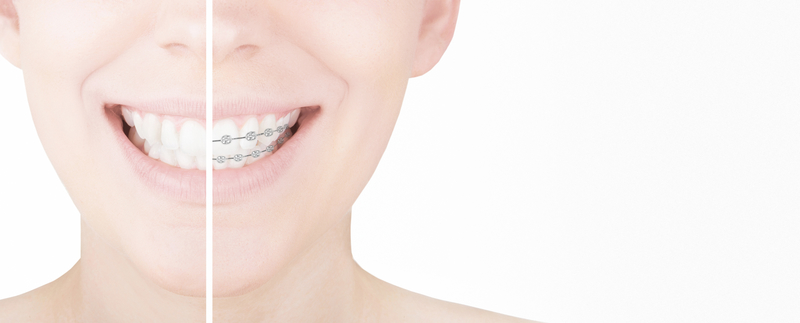
Many orthodontic patients use braces so that they can have straight teeth, but that’s not the only reason why orthodontic care is so important. Having straight teeth can minimize the likelihood of tooth decay and tooth loss while improving your bite, which affects your ability to chew and speak. Correcting crooked teeth can also improve your oral hygiene and strengthen teeth. Learn more about the positive effects that straight teeth can have on your oral health through this guide!
How Straight Teeth Can Help You
One of the main goals of braces is to create a straight smile and correct any orthodontic issues that may prevent teeth from remaining straight. While orthodontics does focus on straightening patients’ teeth, this is not the only purpose of receiving orthodontic care. Whenever a patient has malocclusion, or bad bite, caused by crowded or crooked teeth, daily oral hygiene can become a difficult task. Malocclusion can also stem from teeth that are out of alignment, or jaws that do not meet properly. Thumb sucking or accidents to the teeth can also cause malocclusion. As oral hygiene becomes more difficult to maintain, the likelihood of dental complications, such as tooth decay, periodontal disease, and tooth loss, increases. An improper bite that goes unaddressed can negatively affect chewing and speaking, and wear down tooth enamel. Correcting these problems is of utmost importance to your orthodontist as they seek to give you the best care possible. Orthodontic care that helps straighten teeth can decrease and ultimately eliminate the chances of any of these complications from arising. With straight teeth, patients can better brush and floss their teeth, which will help strengthen them, while easily monitoring any changes that may occur.
What To Expect With Orthodontics
As you begin your orthodontic treatment, there are a few tips that you should know to prepare yourself for what will be expected of you during your time with braces. Although there are some challenges with straightening adult teeth versus children’s teeth due to the pliability of the jawbone, modern technology allows any adult of any age the opportunity to correct crooked teeth with remarkable success. You will first meet with an orthodontist for an evaluation and orthodontics consultation to determine what option is best for your mouth. Any oral health issues, such as gum disease, will have to be resolved before you can begin treatment. Adults have a variety of options to choose from for their orthodontic care, with many discreet options, such as ceramic or clear braces, lingual braces, and Invisalign clear removable retainers, that are available for your needs.
For children, treatment is similar to that of adults and can start as early as the age of 7. Having an orthodontic examination early on can prevent the progression of orthodontic issues that are present and allow the orthodontist to monitor the development/eruption of teeth. Aesthetically-minded treatment options, such as incognito lingual braces, are available for young children who may be self-conscious about their orthodontic care. Most children and adults can expect treatment for 1-3 years, followed by a period of time in which a retainer will be used to keep teeth in their newly aligned positions. Regular dental and orthodontic visits will be necessary to track the progress of teeth and manage any plaque or tartar buildup that could accrue between teeth.
How To Keep Your Straight Teeth Healthy
Once you or your child finishes orthodontic treatment, it is important to continue certain oral health standards to maintain the health of your gums and teeth. Eating a healthy diet, with or without braces, while limiting the amount of sugary foods you consume, will prevent plaque that can stain or damage your teeth. Brushing with fluoride toothpaste and flossing each day will also prevent any plaque buildup, prevent cavities, and keep your teeth clean. Good oral hygiene is especially important for patients wearing braces because you are more susceptible to plaque buildup around brackets and underneath wires. For additional protection, consider using a mouth guard while playing any sports or activities that could damage your mouth, if hit. Creating a good oral health regimen before you start orthodontic treatment will help you have a healthy mouth during and once braces are removed.
For more information on the importance of straight teeth on oral health and what you can do to get the straight teeth that you want, call Belmar Orthodontics at (303) 225-9016! If you’re ready to change your smile for the better, our team is ready to help you reach that goal for you and the rest of your family!
Temporary Anchorage Devices: What Are They?
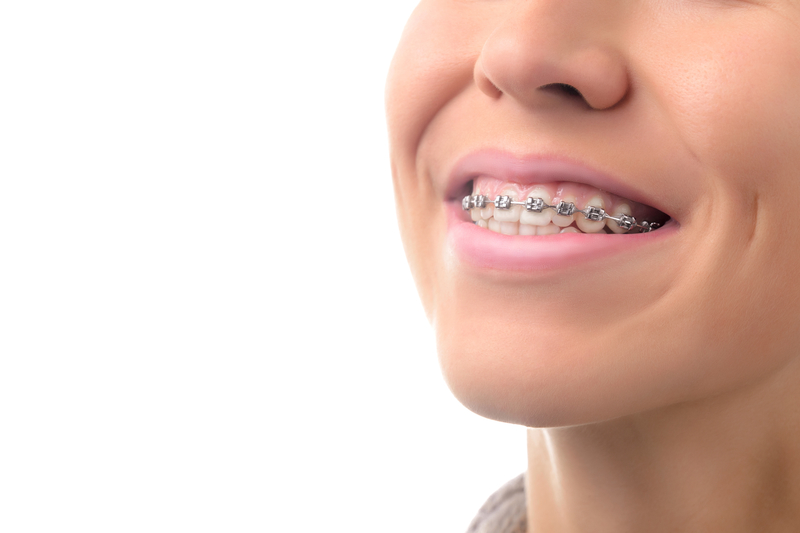
Whenever our teeth need an extra push to shift them into a straighter position, orthodontists will typically install a temporary anchorage device, commonly known as a “TAD.” Although they’re not used in every case, they help pull, push, and lift difficult to adjust teeth into the correct position. If your orthodontist recommends that you have a TAD, read through this guide to understand how they function and what you can do to maintain them!
Origins of Orthodontia
Poorly aligned jaws and teeth have been a nuisance to mankind since the beginning of time, so it’s no surprise that orthodontics has been around for so long. Archaeologists have found human remains with crooked teeth dating back 50,000 years; interestingly enough, the remains of some ancient civilizations, like Egypt, have been found with crude metal bands around their teeth, a form of orthodontics very similar to braces that we see nowadays. The ancient Greek, the Etruscans, and the Romans also practiced orthodontia and kept records of their discoveries. The ancient Greek physician, Hippocrates, was the first to describe teeth irregularities around 400 BC, and centuries later, Celcus would advise bringing newly emerging teeth into their proper position by pushing them with your fingers.
By the 1700 and 1800s, orthodontics was developing rapidly. Pierre Fauchard, the “Father of Dentistry,” would create the bandeau that allowed teeth to align correctly by using a strip of metal with regularly spaced holes that fit around the teeth. During the 20th century, Edward Hartley Angle would identify the true properties of a malocclusion, or misalignment, and begin addressing them with an effective set of orthodontic appliances that were developed much earlier. By the 1970s, braces would further advance through the invention of dental adhesives that would allow orthodontists to stick brackets to teeth surfaces rather than wiring them around each tooth. Stainless steel replaced gold and silver that were previously used as the wire, which helped reduce the cost of braces significantly. Even with the impressive advances that we have made since the beginning of orthodontics, patients around the world still suffer from advanced teeth and jaw malocclusion that normal braces can’t resolve on their own. For the purpose of increasing the effectiveness of braces, other orthodontic devices have been invented to facilitate this process.
Orthodontic Devices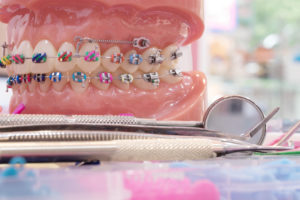
Whenever we think of “orthodontics,” we innately assume braces. Braces have two basic parts: brackets and wires. Wires move the teeth and brackets serve as a stationary holder for the wires. Contemporary braces can be stainless steel, gold-colored, or tooth-colored ceramic. Most braces go on the front of the teeth, but there are some, called lingual braces, that are fastened onto the backs of teeth that are virtually invisible. Lingual braces are not the same as clear aligners, which is another orthodontic device. Clear aligners are made of a transparent plastic-like material and are considered “invisible braces.” They are made to fit the patient’s teeth at different stages of treatment. Each set of aligners is worn for 1-3 weeks for at least 22 hours a day, and are designed to move the teeth incrementally until the next set is used. While these types of braces are a very common sight to see in many homes, schools, and workplaces, they aren’t the only devices used to move teeth and align jaws. Power chains are sometimes used with braces for an added push. They are stronger than the traditional elastic rings and can apply an extra force when needed. The last orthodontic device that is commonly used, although many patients don’t know what their purpose is, is a temporary anchorage device, or TAD.
TADs
Temporary anchorage devices, most commonly known as TADs, are used in some orthodontic cases to help shift the teeth into a straighter position when traditional braces can’t do it on their own. For this reason, not everyone needs them. TADS use titanium mini-screws (sometimes called mini-implants or micro-implants) that provide a fixed object that can be used to push, pull, lift, or intrude teeth that are being straightened. TADS don’t move and can be placed in many different parts of the mouth, so they are highly efficient at moving difficult teeth back into proper alignment. Before TADs are ever inserted into your mouth, though, your orthodontist will evaluate your teeth and determine whether your malocclusion is severe enough to receive a TAD. Before insertion, your gum tissue and jaw area will be numbed so that the procedure will be nearly painless. The TAD is then placed into your jawbone, and will eventually be removed once your orthodontist feels that it is no longer needed for straightening your teeth.
Just like braces, it may take a couple of days for the discomfort to subside and your mouth to get used to the TAD. Try taking an over-the-counter pain relief medication to alleviate any excessive discomfort. An important part of maintaining your TAD is continuing your oral hygiene regimen. Continue to brush your teeth at least twice a day and use mouthwash with antimicrobial ingredients. As long as your gums are healthy throughout the duration of your treatment, you shouldn’t have any complications with your TAD.
Get Straighter Teeth Today
To learn more about TADS, or to schedule an appointment to begin your treatment plan for braces, call Belmar Orthodontics at (303) 225-9016! At Belmar Orthodontics, we have a highly skilled and experienced team that is happy to help you start your journey to a healthier and happier smile.
Dental Emergencies With Braces

Braces are incredible devices that can help transform your teeth and reshape your jaws. However, they are not always fool-proof. Every so often, a patient will have a dental emergency. That may be a bad cavity that needs to be fixed, or a bracket or wire will break. There are only a few dental emergencies that can happen with braces. We can help you to know what to do when each of those emergencies happen!
Origins of Braces
Orthodontic treatments have been around for a long time-even as far back as the ancient Egyptians! Although their ways were archaic, people for centuries have been trying to fix crooked teeth and develop a prettier smile through orthodontic work. The ancient Greeks, Romans, and Etruscans were known to have practiced orthodontia, and interestingly, the Etruscans used to attach gold bands to women’s teeth to preserve the position of their teeth after death. Orthodontics saw a surge in progress during the 18th century thanks to Pierre Fauchard. Known as the “Father of Dentistry,” he invented an appliance called a bandeau, which was a horseshoe-shaped piece of metal with regularly spaced holes that fit around the teeth to correct the alignment. He would also use forceps to physically realign teeth into their correct positions and tie them to neighboring teeth until they healed.
Orthodontics in the United States exploded during the 19th century. J.S. Gunnell created a type of headgear that fashioned to the head and exerted a soft pull on teeth while Charles Goodyear invented vulcanized rubber which would eventually become one of the most commonly used appliances in orthodontics. But Edward Hartley Angle, the “Father of Modern Orthodontics,” took orthodontics to another level by identifying the true properties of malocclusion, or misalignment, and addressed them with his own set of orthodontic appliances in 1880. Until the 1970s, orthodontist would attach anchored brackets around each tooth with winding wires, but with the invention of dental adhesives, orthodontists could then stick the brackets to teeth surfaces. Stainless steel then replaced gold and silver as the most popular option for wires, due to its manipulability, and became the most cost-efficient option for braces.
Dental Emergencies and What To Do About Them
Braces have come a long way since their beginnings many centuries ago, but as braces have evolved, so have the problems that come with them. Although dental emergencies are few and far between when it comes to braces, there are some common issues that can be readily addressed and fixed if serious enough. The least serious issues that you can have with your braces is tooth tenderness and lip and cheek sores. As your teeth become accustomed to your braces, your teeth will most likely be sore for 2-4 days. Using headgear, rubber bands, and springs can add to this soreness, but that discomfort normally goes away in the same amount of time. Eating soft foods and taking an over the counter pain reliever can help dull the ache. Loose or broke bands and brackets are also another annoyance that sometimes occur with braces. Although not considered an emergency, they normally break due to patient’s eating prohibited foods or picking at their braces. Whenever this occurs, place a piece of wax on the spot of irritation and wait until your next orthodontic appointment, unless the broken bracket breaks on one of the upper or lower front four teeth, then call your orthodontist as soon as possible.
Protruding wires are not only bothersome, but can stab the inside of your lips and mouth if not fixed. Wires can come loose from eating sticky foods, like candy, or by picking at your braces. If this has occurred, try using a Q-tip or pencil eraser to push the wire in towards the teeth. To avoid accidental damage to the wire, make sure to not bite your nails or pens and pencils. In rare occasions, a piece of the appliance may break and be swallowed by the patient. Although alarming, keep calm and have someone look in your mouth to see if the appliance if visible. If confident that you can remove it, you may carefully attempt to do so. If you are unable to see the piece, are coughing excessively, or having difficulty breathing, that could be a sign that the piece could have been aspirated and you should contact your orthodontist immediately.
How To Protect Your Braces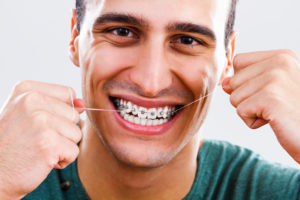
Unless under extenuating circumstances, most dental emergencies are avoidable. Maintaining good oral health and hygiene throughout your time with braces is vital in ensuring healthy teeth and gums, and preventing cavities. Food particles are easier to get stuck between braces, and when not cleaned thoroughly, can lead to other dental emergencies, like tooth decay, which can cause major complications. Hard foods, sticky foods, and foods high in sugar should be avoided as they are known to break brackets and cause cavities, which you more susceptible of developing while wearing braces. Some of the need-to-avoid foods include hard candy, nuts, apples, popcorn, ice, gum, caramel, and licorice.
Because braces are so notorious for getting food stuck in them, make sure that you are brushing after every meal to prevent staining and reducing bacteria buildup in your mouth. Use a soft brush, and brush each tooth by starting at the top and brushing down, then repeating the motion and brushing up around each bracket. Use threadable floss of a floss threader to get the hard to reach areas in between teeth that are covered by the archwire. Using the pointed end, insert between the teeth and gently move the floss back and forth between the two teeth. For added care, use a proxabrush, sometimes called a “Christmas tree brush,” to scrub between each bracket in an up and down motion to get any extra gunk that might be stuck there. For any dental emergencies that you might be having, make sure to contact Belmar Orthodontics at (303) 225-9016 for your next consultation!
Dental Services You Need During Braces
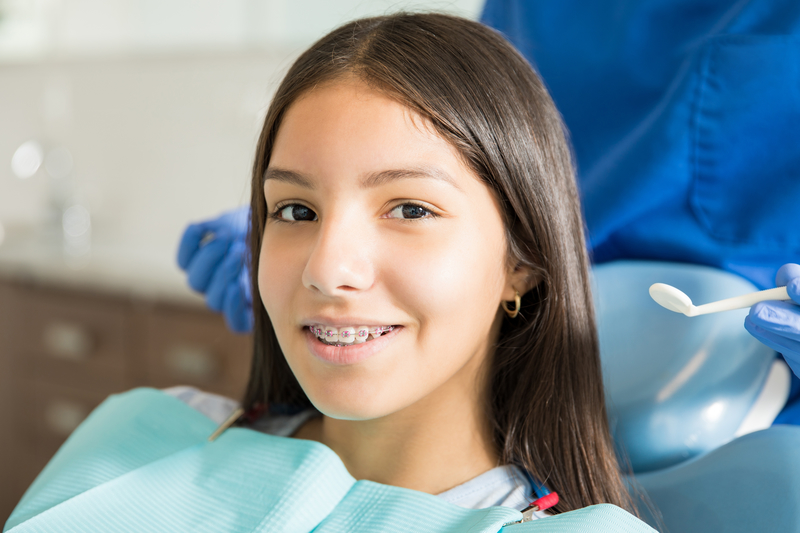
Getting braces through an orthodontist does not mean you should stop seeing a dentist for dental services. In fact, you may even need to get dental services more often with braces. This is because brackets and wires inevitably raise your risk for getting food and plaque stuck in your teeth. Those substances can then lead to quicker tooth decay, gum problems and tooth erosion. Find out what you can expect from your orthodontic visits and why you should keep scheduling in dental services during your treatment.
How Do Braces Change Your Teeth?
Not everyone will get braces during their lifetime. However, for those that do, they can change a smile in incredible ways. You may see children wearing braces from time to time. This is just so they can get a great smile, but that is part of it. Children should see the orthodontist around age 7 or 8 to determine if bite or alignment issues are present. If so, a child could grow up with speech impediments, problems with tooth decay and gum disease, and difficulty chewing, eating and biting. With interceptive orthodontics—or child orthodontics—we can correct those problems so a child develops properly.
With adults and teens, straightening treatment generally starts around age 11 or 12 and older. This is when most (if not all) of the adult teeth have come into the mouth. However, it’s common for the adult teeth to come in crooked, which can make people self-conscious about their smiles. When patients decide to get braces to straighten their teeth, studies show that confidence grows and people show their smiles more. That confidence can lead to more success in the future, motivation to do more and be more, and better oral health.
Straightening the teeth makes the teeth easier to clean. This is because crooked teeth can create areas in the mouth where the teeth are incredibly hard to clean. If you can’t brush nooks and crannies well or if you can’t pass floss through the teeth, those areas are likely to decay. Teeth that are crooked or at different angles also have different amounts of pressure placed on them, which can cause the teeth to crack or break under pressure. That is why straightening the teeth can help prevent not only dental emergencies, but also problems like tooth decay and gum disease.

Changes You Want to Avoid
With your dental health, you always want to invest in dental services like dental cleanings, comprehensive exams and your own at-home cleaning. If not, you can start to develop problems with cavities and gum disease. Both of these conditions (as well as bad breath, oral sores and more) stem from poor oral hygiene. When you eat, bacteria in the mouth mix with sugars in your food to create a sticky film called plaque. That film is acidic and it sticks to your teeth instead of being swallowed. The acid erodes the layers of your teeth, decaying them to create cavities. This is how they form, and they can happen much easier with braces.
Three types of braces you can choose (traditional, lingual, ceramic) will require brackets and wires attached to your teeth. The brackets are bonded to the center of your teeth, with a wire that runs through them. Your brackets are areas where plaque and food can easily get stuck. If they become stuck or particles build up around your brackets, this can create areas of decay rather quickly. Many people also don’t floss like they should with braces because it takes just a bit longer. However, when food sticks around and you skip flossing, you are leaving about 40% of your tooth surfaces open to decay. That means, when you get your braces off, you’ll be left with areas of tooth erosion (or craters) and cavities.
You also want to avoid foods with dyes in them, including drinks. When you drink or eat something with dyes (like blueberries, strawberries, blackberries and drinks died those colors), then your tooth color can change over time. This could mean that you have small squares on all of your teeth at the end of treatment that are a different color than the rest of your teeth. Soda, juices and carbonated drinks can all do this as well, except that they will also wear away parts of your teeth.
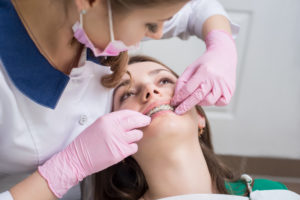
Continue Dental Services During Braces
All of those changes to your teeth can be avoided if you keep up on your personal hygiene at home and dental services in-office. This means, you should:
- Brush your teeth every single day, after every single meal, for two minutes each time you brush. Practice brushing at 45-degree angles to dislodge food from brackets and cover all the tooth surfaces. Use a proxabrush to dislodge stuck food even easier.
- Floss each day, at least 1-2 times. Use a floss threader or threadable floss to make this easy for you.
- Use a waterpik tool if you tend to get food stuck in specific places.
- Keep up on your braces adjustments and your orthodontic appointments.
- For dental services, make sure you visit the dentist at least twice a year for comprehensive exams and dental cleanings.
We want to focus on that last one. Dental cleanings and comprehensive exams are so important for the health of your mouth. With dental cleanings, the hygienists can do thorough cleanings on your teeth and brackets and spot the signs of erosion, decay and color changes. Those professionals can spot the signs of decay and gum issues. If needed, we can work with them to remove certain brackets where dental work is needed. Orthodontists and dentists are not the same even though they have had the same schooling. Make sure you are visiting both during your time with braces. If you want to avoid problems with cleaning brackets and wires, ask us about our Invisalign treatment option. You can do this by calling Belmar Orthodontics at (303) 225-9016!
What are the Benefits of Lingual Braces?
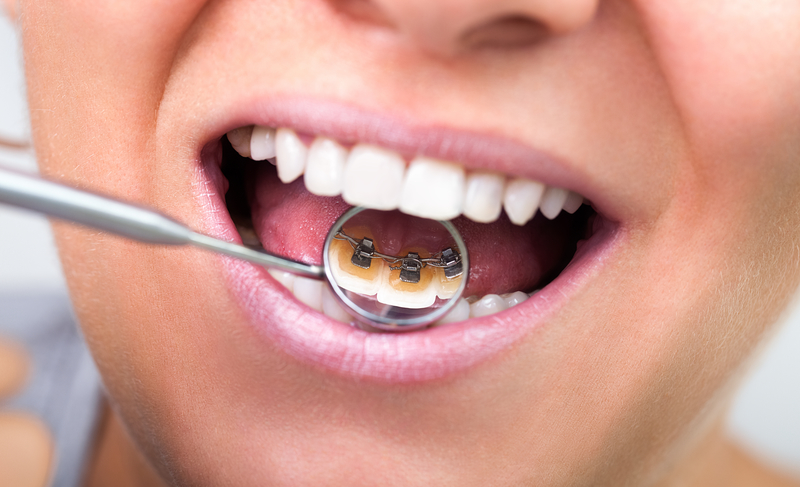
Many patients are getting excited about lingual braces as an option for their orthodontic care. These types of braces can correct long-term or lifetime dental issues. They are also hidden in a patient’s mouth and because they’re not on the front of the teeth, they are a perfect option for athletes or musicians to perform better. Thinking about leveraging the power of lingual braces to straighten your smile? Consider the benefits that lingual braces can offer you and ask about your set today!
What’s the Difference Compared to Other Options?
Lingual braces is an exciting option for patients who want to combine the benefits of Invisalign transparent aligners with the sturdiness of traditional metal braces. These type of braces are also known as “incognito hidden braces” because they rest behind your teeth instead of on the front. They too, are made from metal, except this metal is usually gold instead of silver. Plus, instead of simple brackets and wires, the metal attachments cover the entire back of your tooth surface.
There are brackets and wires, but they are on the tongue-side of your teeth. Lingual braces are amazing because they can achieve the same results as traditional orthodontics in a manner that is inconspicuous and undetectable. They are tightened at each appointment just like traditional braces and can correct bite and alignment issues with ease. How do you benefit from these type of braces?
- Correction of long-term or lifetime dental issues
- Less noticeable orthodontic treatment
- Good orthodontic treatment for athletes and musicians who play wind instruments
- Increased confidence during treatment compared to traditional methods
- Elevated self-esteem after treatment
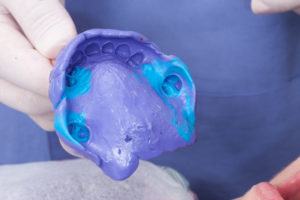
Difference Between Lingual and Traditional Braces
Not all metal braces are alike. Even though lingual braces are made out of metal alloys, they are still different than traditional metal braces. Metal braces rest front and center on a patient’s teeth. They consist of the classic brackets-and-wires set-up, but they can make your smile look gray because of the metal. Depending on your oral health, you can have tooth staining and dental erosion during your time with braces. This can leave marks when the braces come off.
Compared to traditional braces, lingual braces are more ideal for athletes and musicians. Traditional braces can make it difficult for musicians to play wind instruments and can affect how a person blows. For athletes, they have to worry about dental emergencies caused by metal brackets and wires if they get hit in the mouth. There are no brackets or wires on the front of the teeth that will cut up the cheeks if a person gets hit in the face. However, both of these styles of braces are extremely effective at correcting bite and alignment issues.
Comparing Lingual Braces to Ceramic Braces
Ceramic braces are very similar in their style to metal braces. The only difference is that they are made from white, ceramic material instead of metal. Even the wires can be made white to match the teeth. This is a more aesthetic option for teens who like metal braces but don’t want them as noticeable. However, they are still much more noticeable than hidden braces would be. A teen or adult simply has to decide how noticeable they want their braces.
Invisalign Vs. Lingual Braces
If patients want hidden braces, then why not just use Invisalign treatment? This is a great orthodontic option, but it has its limitations. Yes, Invisalign is transparent on the teeth. However, those aligners cannot correct many bite and alignment issues, which many patients need. They are more ideal for patients who only need their smile a bit straighter. For any major orthodontic issue and especially bite problems, Invisalign is not the best option. Lingual braces combine the hidden aspect of Invisalign treatment, but with the sturdy structure of metal braces that can correct bite problems.
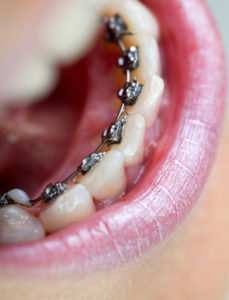
Choose Orthodontic Care
No matter what orthodontic option you choose, simply opting to receive orthodontic care for bite and alignment issues will improve your oral health immensely. Some people skip receiving orthodontic care because they believe they will save all that money. However, crooked teeth and bite issues can actually cost more money in the long run. How you ask? When your teeth are straight, they are very simple to clean with a toothbrush and quick to floss. However, when they are crooked, you will consistently miss many parts of your tooth surfaces. This can lead to quick decay, which will take dental work for every instance of tooth decay.
Flossing also gets very difficult when the teeth are crowded or crooked. A patient may not even be able to pass floss between the teeth if they are too crooked. That’s detrimental to a patient’s health, as 40% of tooth surfaces can only be reached through flossing. That leaves those tooth surfaces open to decay, enamel erosion, staining and infection. If this happens all over your mouth, you’re looking at spending a lot of money over a lifetime to fix all your oral health problems.
Get Your Braces
Opting to receive orthodontic care saves you the headache of bite and alignment issues, crooked teeth, and decay and gum disease that can happen. Correct these issues early-on and enjoy your smile for life. Call Belmar Orthodontics today at (303) 225-9016 to learn about lingual braces and your other orthodontic options!

